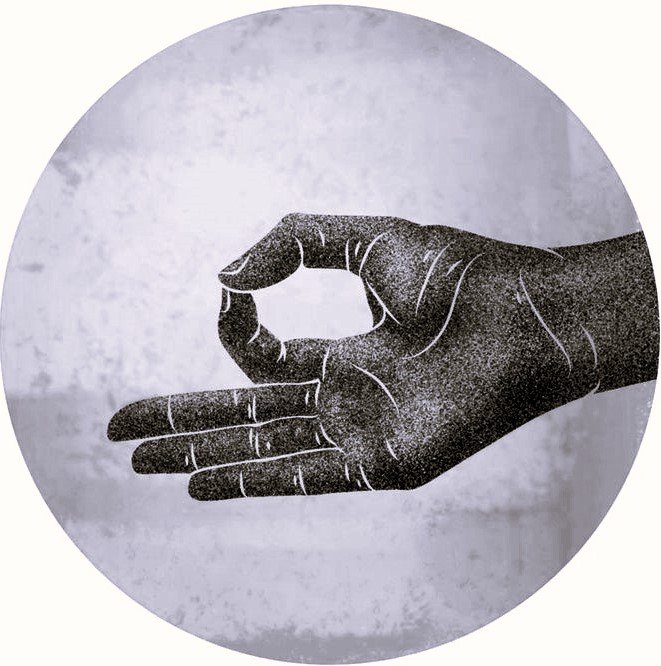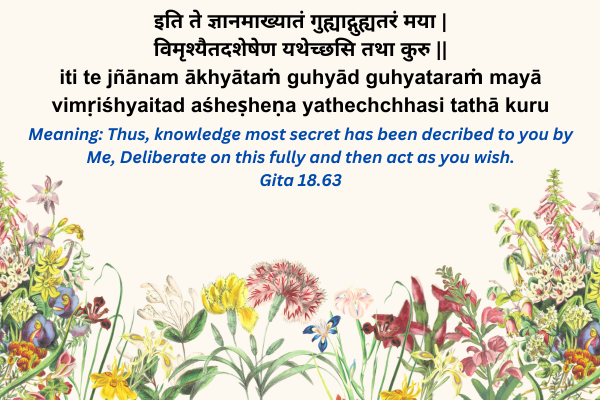Since all 4 Mahavakyas refer to the Supreme Brahman or Consciousness directly, we will also understand the significance of Jnana Mudra or Gesture of Knowledge (Jnana means “knowledge” and Mudra is “Hand gesture” or symbol) as this Mudra also symbolises merger with the Brahman.
In my previous blog on “Pancha Bhutas or Five Elements”, apart from the Five Elements, we looked at Five Sense Organs & Five Objects of Perception & Five Objects of Action. Now, Jnana Mudra involving our Five Fingers is also significant in understanding more about Brahman. In Sanatana Dharma, it is to be noted that symbolism plays an important role in making us understand its core concepts easily.
Please refer to the picture above. Our little finger symbolically represents Body or the Plant Kingdom, as plants only have a Body. The ring finger denotes the Mind and together with the little finger represents the Animal Kingdom, as animals have both Body & Mind. When animals are hurt the cry in pain, because they have a mind. The middle finger represents Intellect and together with body & mind represent us, the Homo Sapiens or Humans. It is the Intellect that differentiates Humans from all other species on earth.
The index finger represents our Ego , which is also a result of ignorance. Man develops ego when he identifies himself with his body, mind & intellect, together with 3 Bodies (gross, subtle & causal) & 3 Gunas (Sattva, Rajas & Tamas). Duality among human beings is a consequence of the merger of all these four (Body, Mind, Intellect & Ego)! The thumb, repesents the ATMAN or Brahman or Supreme Consciousness! When the index finger is bent towards the middle of the thumb, it forms a circle. This indicates the mental separation or detachment from the 3 bodies & 3 Gunas and merger into Brahman. A circle has no beginning or end, it is INFINITE, symbolizing the infinte Brahman. This is symbolic gesture means – “I bow my ego (index finger) down to the supreme brahman (thumb)”. Hence the meaning of this Mudra is very profound and used during meditation.
Difference between Jñāna (Knowledge) & Vijñāna (Wisdom) & How to remove “Ignorance”:
Jñāna means knowledge & Vijñāna is wisdom. A teacher can impart only knowledge, he cannot impart wisdom to his pupil. One can get get knowledge through books & Guru or Teacher. Wisdom has to be gained by oneself. The former is received externally and the later internally by the individual! But first comes the process of removing ignorance which is the cause of EGO! (In my blog on Cosmic Dance of Lord Shiva, Sl No. 8 shows how Ignorance or Ego is symbolized as Apasmara, unwanted speech).
Ignorance is because of 1) lack of knowledge 2) lack of comprehension or understanding & 3) lack of skill & knowledge to do something. The first one can be overcome by listening or “Śravana” with a calm, attentive & receptive mind. This is a first step and important step which involves both listening to the guru or teacher & reading books & scriptures. Unless we have done both, we cannot contemplate or understand the Self! The second step is “Manana” which is reflection or comtemplation or deliberation!. This requires self effort and needs to be done independently by oneself. Only upon independent reflection can be fully understand what has to taught to us. The third & final step is “Nidhidhyāsana” or meditation which can be mastered through repetitiveness & consistent effort. This process is where we focus our mind on supreme self or Brahman by excluding all other thoughts in a single pointed concentration to merge with the Brahman. This is the final destination and the end of our journey. With this merger there is nothing else to know, understand or be aware of!
Recap on Brahman & Conclusion:
A quick recap is given below:
- A Human Being consists of Spirit & Matter.
- Spirit is the Atman or Brahman (One that Knows- Formless) – Supreme Self or Consciousness.
- Matter is the Body-Mind-Intellect equipment (Object of Knowledge/that which is known – Has Form).
- Body is made up of Gross Matter (Sthula Sharira).
- Mind & Intellect is made up of Subtle Matter (Sukshma Sharira or Linga Sharira). Emotions & Feelings. Love, Anger, Hatred, Kindness, Passion, Envy, Possessiveness, Avarice etc. belong to the Mind. Beyond the Mind is the Intellect. The Intellect is our faculty to think, reason, judge & decide. These three – Body, Mind & Intellect are INERT and “insentient” by themselves. But on coming into contact with Atman (Spirit), they gain “sentiency” (means the ability to feel /perceive things)
- Causal Body (Karana Sharira): Causal body, the most subtle of the 3 bodies, contains “Vasanas” which are a bundle of “stored” desires & impressions from our past lives in the un-manifest form and it also is the seed of future experiences. Causal Body or “Seed” manifests first as Subtle Body (consisting of thought, emotions & desire) and further manifests as gross body which perceives & acts.
Atman or Brahman is the core, pure consciousness and the body, mind & intellect envelop it. The Atman, the self is ever at rest. The wise man identifies with the inner Self and merely allows his body, mind & intellect to operate and by doing so he becomes impersonal, detached & objective. His mind becomes peaceful while his body is remains active & dynamic. This is the key to success & progress in life!
In Bhagavad Gita, Krishna gives the option or choice to man – either to succumb to the play of his senses or rise beyond the body, mind & Intellect and merge with the Supreme Brahman! This is stated in the Verse 18.63 below:
Commentary:
The words “yathechchhasi tathā kuru” means “act as you wish”. Krishna gives the Arjuna the choice of action. It shows that Krishna has a humble and open minded approach, as He does not want to impose his views on Arjuna. If something is forced on people, it can be outrightly rejected. Therefore, man has to be given the freedom to delibrate and arrive at his own conclusions. This sacred knowledge which deals with the Divine is referred to is known as “Brahma Vidya, the knowledge of Brahman. The purpose of Brahma Vidya is to lead man from untruth to truth, ignorance to light & death to immortality.
References: Snippets from “Vedanta Treatise” by Swami Parthasarathy

